Section 4. Inside Playing the Learning Power Game
In this section we give you a flavour of the content of Playing the Learning Power Game which is Phase 1 of the programme. This phase is expected to take a school about a year to work through, but many of the resources are rich enough; to be useful and returned to year after year.
The programme is made up of four units:
- Unit 1 introduces learning journey charts for 12 behaviours and invites teachers to translate charts into learning profiles for their students;
- Unit 2 concentrates on the culture of the classroom and how small tweaks in teachers’ behaviours can benefit students’ learning behaviours. The emphasis is on just four learning behaviours; perseverance, questioning, collaboration and revising;
- Unit 3 purposefully explores how the curriculum itself provides the need for specific learning behaviours to be used and how this then shapes lesson planning;
- Unit 4 begins to branch out to a further eight learning behaviours offering a staged way of introducing them to students.
You are now in section 4. Inside ‘Playing the Learning Power Game’.
Use the navigation bar to move between sections.
This on-line programme aims to help you to discover your students’ learning behaviours and, with that knowledge, enable you to fashion your classroom culture and teaching methodology to ensure students, knowingly, become better learners.
The big ambition of Phase 1.
This chart shows the big ambition of the programme. It distils what it’s all about.
- the cells in yellow capture what leaders, teachers and learners will need to do across each row:
- tracking the growth of learning behaviours;
- adapting classroom cultures to strengthen 4 key learning behaviours;
- adapting how the curriculum is delivered in order to build 4 key learning behaviours;
- experimenting with and expanding the number of learning behaviours consciously being used by students;
- the blue boxes capture the outcomes such changes could make to classrooms; cultures and curriculum delivery.
- the green boxes capture the anticipated outcomes for people; leaders, teachers and learners.
Read more about the Big Ambition at your leisure
The vertical and horizontal axes of the grid
The vertical axis to the left shows the 4 main aims or thrusts of the programme. These four components involve:
- Unit 1. The formative work of finding out about your students’ learning behaviours and how they have the potential to improve/grow;
- Unit 2. The practical work of shifting classroom culture to better accommodate learning behaviours, using 4 foundational learning behaviours to get you started;
- Unit 3. The practical work of purposefully blending the use of learning behaviours into lesson design, again focusing on just four foundational behaviours;
- Unit 4. The work of gradually bringing more of the original researched learning behaviours into play in order to build students’ use of them over time. This is in preparation for the Phase 2 programme.
The horizontal axis across the top shows the 3 main groups of players in the game and what they will need to do to make it all work.
The central 12 cells
These cells serve 2 purposes. Firstly:
- The text in each cell gives an indication of who needs to do what, in very broad terms, at each stage of this journey;
- When looked at vertically down the page, they map out the 4 stages of this first part of the learning power journey;
- When looked at horizontally across the page, they show the players in the game and how what they do needs to interact.
The cells to the bottom and to the right
The green cells across the bottom give an outline of how the school’s players will have developed by the time you have finished this first stage programme. The blue cells to the far right give an indication of the anticipated outcomes for each part of the journey from; discovering students learning behaviours, to shifts in classroom cultures, to early shifts in lesson design accommodating learning behaviours, and to the beginning of consciously using a much broader range of learning behaviours across the curriculum.
About Unit 1
Three basic frameworks
The early sections of Unit 1 offer a swift and illustrated read about how the learning power approach has been researched over time and its now three foundational models or frameworks…the learning behaviours (the warp of learning, shown as a brain diagram), the teaching behaviours that ensure their use (the weft of learning, shown here as a palette) and the phases of progression which add intent and purpose to every students’ journey (shown in charts).
Developing students’ Learning Power could be seen as the warp and weft of learning, a tapestry of activities on the part of both teachers and learners. The warp of Learning Power is made up of the learning behaviours you want students to develop. These are developed and woven together by the weft of all the different methods that a teacher has at their disposal. In recent years this development journey has moved from being a broad outline to one with identifiable progression stages. This means that the language teachers use; the explicit attention they pay to the ‘how’ of learning; the activities they make available, and how these are framed for students are now positively designed to enable students’ progress in the development of their learning habits. Teachers are enabled to look at their own students through the progression charts of learning power and use these to focus how they build the learning behaviours.
Unit 1 gives teachers opportunities and encouragement to;
- discover and understand what ‘good learners’ tend to be like
- take a look at themselves through a learning behaviour lens
- tentatively consider the learning behaviours of a couple of students
- remind themselves of how learning behaviours progress
In getting to grips with the growth of learning power teachers take a personal look at themselves as a learner and the learning behaviours they tend to use. This self-analysis results in a learning profile showing their learning strengths and the behaviours they find tricky and would like to improve. This sets the stage for teachers to begin profiling their students before moving on to Unit 2. Discovering and recording this data is likely to take a couple of months.
About Unit 2. Classroom culture
The second unit takes a look at the culture of the classroom and enables teachers to try out a range of ideas that have been found to work well in improving learners’ disposition to learning. It is expected staff will spend about 3 months working on this, but they are likely to keep returning to it over time.
Developing three aspects of classroom culture
In Unit 2 teachers are enabled to explore their work through three aspects of the Teachers’ Palette framework – Relating to, Talking about and Celebrating learning behaviours. They then go on to trying out and using a range of teaching ideas linked to the 4 key learning behaviours – Perseverance, Questioning, Collaboration and Revising.
We start with these four behaviours because with Perseverance teachers find that it’s this disposition to keep going, to remain engaged, to relish challenge and strive for goals that’s most lacking in many students. Questioning because this is the driver of learning; wanting to know why, how, if, when and so forth connects us with learning. Collaboration because ‘working together’ is a familiar classroom activity and yet few students know how best to learn profitably together.Revising because learning is a process and like any process it needs managing and adapting to work really well. This foundational set of four offer the soil in which other dispositions can take root more easily.
The content builds on what teachers have discovered about their students’ learning characteristics in Unit 1 and offers interventions tailored to particular levels of learner development across the four learning behaviours. The suggested changes in practice include;
- enabling students to take increasing responsibility for their own development. i.e. students asking more of the questions, monitoring their own learning or making more choices
- moving away from ‘telling’ whenever possible and adopting the role of coach
- showing yourself as a learner by modelling your thought process and displaying uncertainty
- encouraging students to pay attention to how they are learning, to slow down and notice steps they are using
- finding ways to notice and celebrate learning behaviour growth
- showing how… mistakes can become learning opportunities; difficulty is when learning happens; struggle is to be expected; asking questions shows curiosity not a lack of intelligence; effort not just talent is what leads to success
- displaying the process of learning by showing first attempts, revisions, failed lines of enquiry. What you choose to display tells students a lot about what you truly believe: displaying/praising only the finished article suggests that whatever we might say, we are more interested in the outcome than in the process.
These ideas and more are offered as a catalogue of teaching ideas, clustered into the 4 foundational learning behaviours (the columns) and differentiated by the phases of learner development (the rows). This builds on what teachers discovered about their students’ learning characteristics in Unit 1. Now their interventions can be tailored to particular levels of learner development.
Here teachers will consult their class profile, consider which of the four learning behaviours need most encouragement and begin to edge these into the culture of their classroom.
One example of the practical ideas catalogue
Putting ideas into practice
Here’s just one example of the sort of practical ideas teachers will find in the catalogue. It’s an idea to help perseverance (and questioning) edge from Purple to Blue stage (from ‘Show me’ or ‘tell me’ to ‘I’ll try’) in the learning chart.
Make students aware of how they will be learning
Share learning behaviours with students
Some primary schools have found it useful and effective to share an overview plan of a couple of learning behaviours that they will be using during a week. Here the information is captured on a large poster which remains on the classroom wall throughout the week.
The teacher tends to share an overview of learning for the week … decimals … poems … ball skills and then explores which learning behaviours will really help with this content. If the class is not at this level of discussion the teacher provides brief explanations of the behaviours.
The bottom box on the poster captures the result of a class/group discussion of how the habits had been used and what students had found out to take forward in using them next time.
About Unit 3. Constructing Learning
Taking a deeper look at learning
This Unit is possibly the one many teachers need most. It helps them to answer the question ‘how can I introduce questioning into my lessons?’ or ‘what does a learning powered lesson look like?’ or ‘how does all this fit together across the curriculum?’ It is expected staff will initially spend about 3 months working on this, but they are likely to keep returning to harvest ideas from this unit over time.
Unit 3 concentrates on the focal point in the Teachers’ Palette framework, Constructing, where classroom culture meets curriculum culture. What can teachers do with a given curriculum to ensure it is ‘taught’ or perhaps ‘learned’ in a way that will enhance and strengthen students’ learning behaviours? It’s about direct teaching, curriculum design and planning lessons. It’s about looking at the curriculum in general and thinking about how to infuse learning behaviours into it. It’s about thinking and planning schemes of work or day to day lessons to ensure students consciously use and improve their learning behaviours. It’s about how teachers handle the day to day, hour by hour stuff that enables students to understand themselves as learners. It’s about making learning power come alive across the curriculum.
Section 3A considers the transition from content-only planning through to curriculum planning that integrates progression in content with progression in learning behaviours. This aspect of the programme is of particular interest to senior managers.
Section 3B considers how teachers might plan a unit of work and then just one lesson to ensure learning behaviours are firmly embedded. In fact without the use of learning behaviours the plan would be unsuccessful. It looks at the stages of filling in blank unit plans. It looks at possible must haves and top tips for planning a worthwhile lesson. Teachers will find all sorts of tips, formats and examples to get them going.
Section 3C explores different types of learning activities and the learning behaviours that they stimulate. Activities come in all shapes and sizes – some are highly structured by the teacher others encourage learners to engage in independent enquiry.
Section 3D. Here teachers will find a unique catalogue of activities to explore. It has over 100 ideas that they might blend into their lesson designs. These ideas are organised into 4 categories for each of the 4 foundational learning behaviours. The 4 categories are:
- Visible Thinking Routines – to activate each of these learning behaviours;
- Classroom Activities – to strengthen each of these learning behaviours;
- Monitoring Strategies – for checking how each of these learning behaviours are developing;
- Exemplar Lessons – A lesson plan that integrates each of the four learning behaviours into a complete lesson.
It’s a must-have pick and mix. Expect staff to come back to it frequently.
An example idea
Putting ideas into practice… a Visible Thinking Routine
This VTR helps students to reflect on how and why their thinking/understanding is changing.
Remind students of the topic you have been working on. Ask them to respond to each of the sentence stems: I used to think…, Now, I think…
Alternatively ask students to write down their views at the beginning of a topic. Invite them to revisit & update their answer during and at the end in light of what has been learned.
Or, at the beginning of a lesson ask students to write down what they understand by a particular term that will be explored in the coming lesson (e.g. Phrase (English); Proof (Maths); Power (Science) etc). At the end of the lesson, ask them to write down what they now understand by the term.
About Unit 4. Broadening the range
This unit offers teachers an opportunity to spread their wings and begin to work across the other eight learning behaviours. It has eight small sections, each based on one learning behaviour – Noticing; Making Links; Reasoning; Imagining; Capitalising; Listening; Planning; Meta Learning.
For each of the eight behaviours teachers are offered example activities for a staged way of introducing the behaviour by:
- Firstly… making students aware of the use and importance of a habit…when, where, why, how they could be using it;
- Then... exploring the learning habit a little more through its language;
- Try... using the behaviour as a lesson starter to tune students into using it;
- Then start... blending the behaviour into the way teachers teach content, using specific strategies to deepen content understanding;
- Ensure… students reflect on the success or otherwise of their new frame of mind as a result of consciously using the behaviour.
The content of this section encourages teachers to play with introducing more learning behaviours.
This Unit offers an effective preparation for Phase 2.
You are now in section 4. Inside ‘Playing the Learning Power Game’.
Use the navigation bar to move between sections.


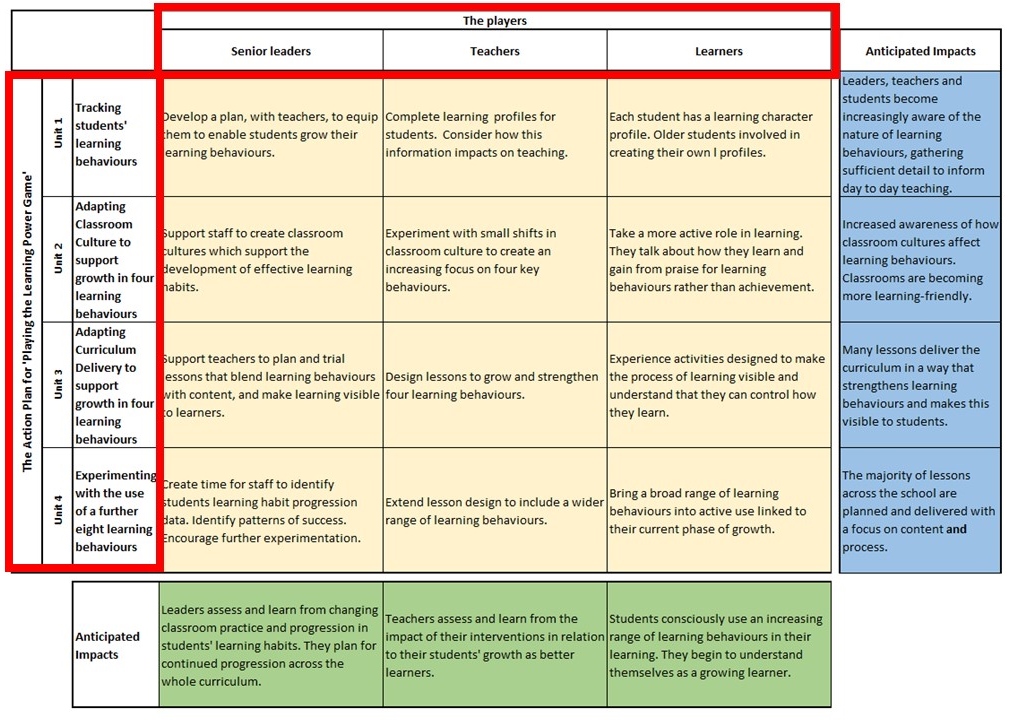


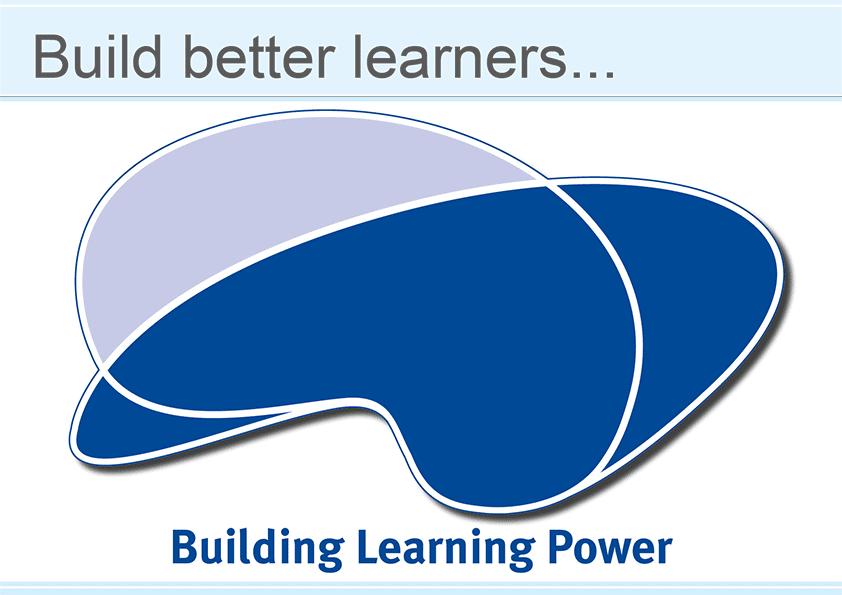
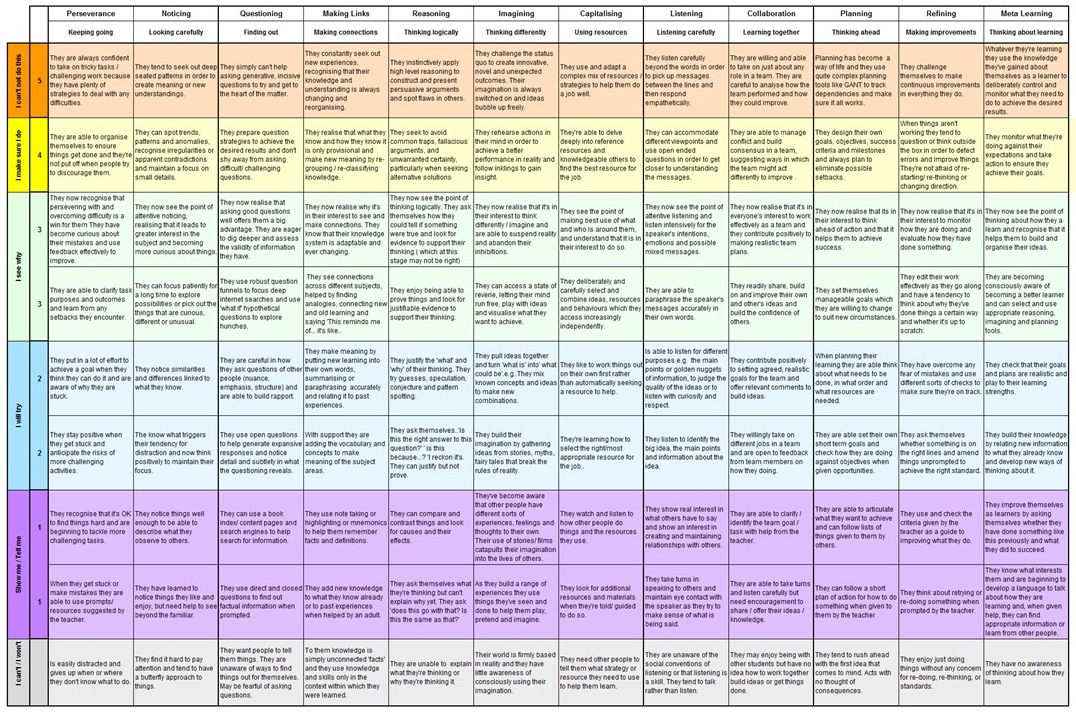

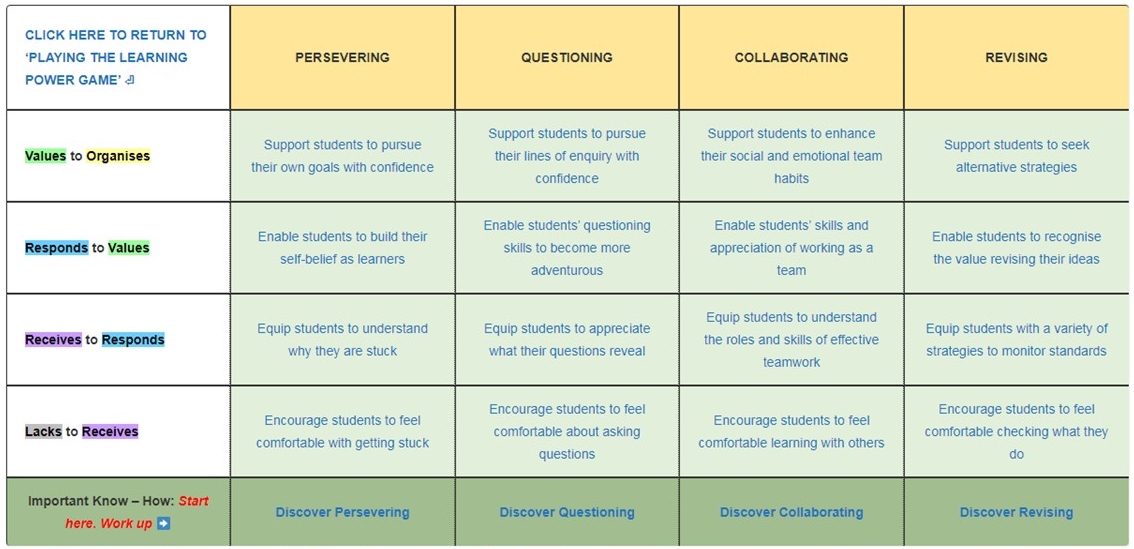
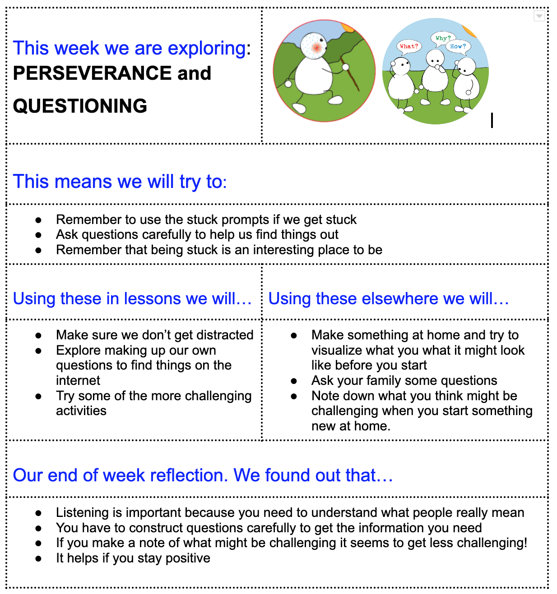
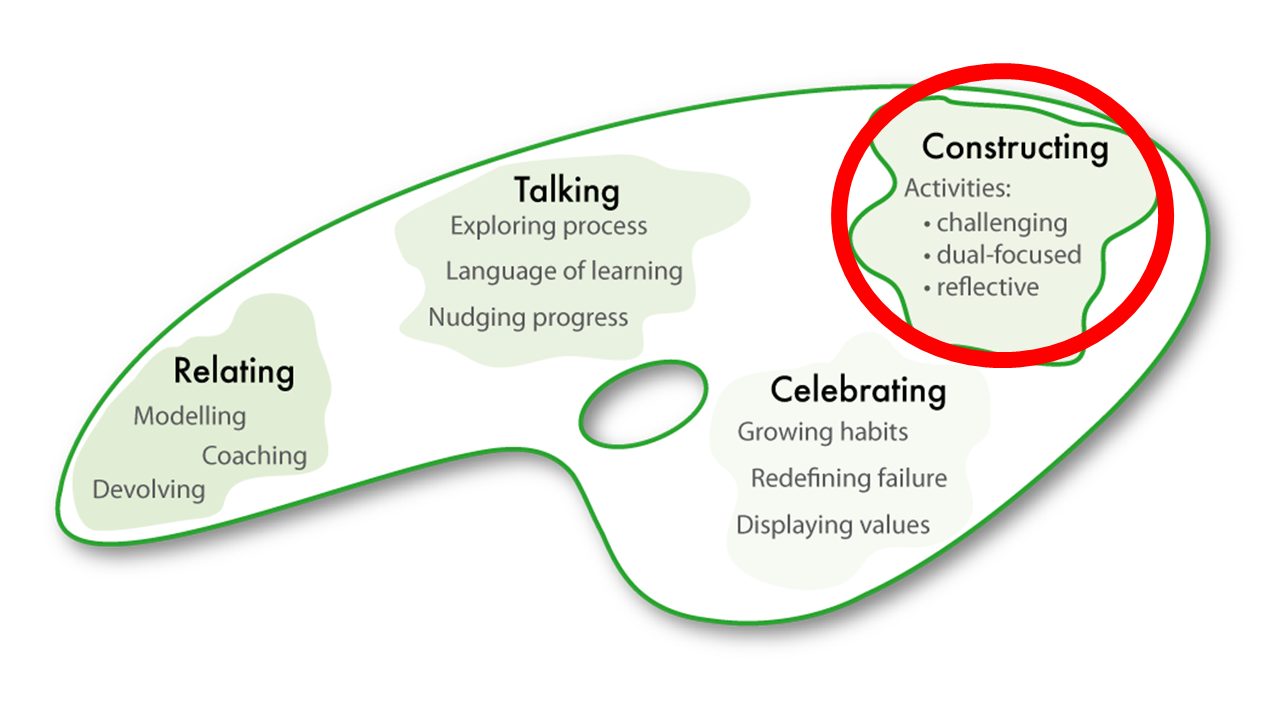
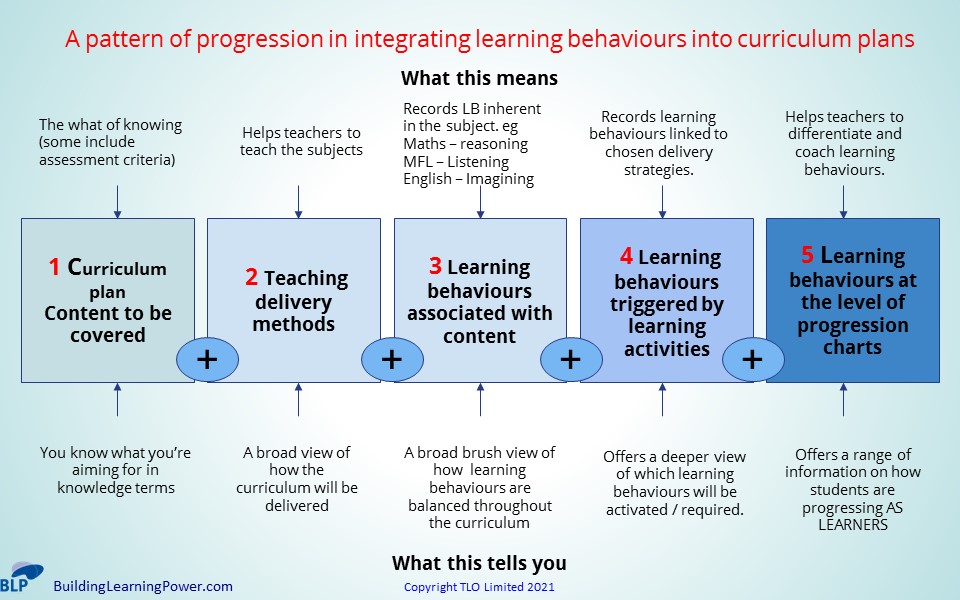
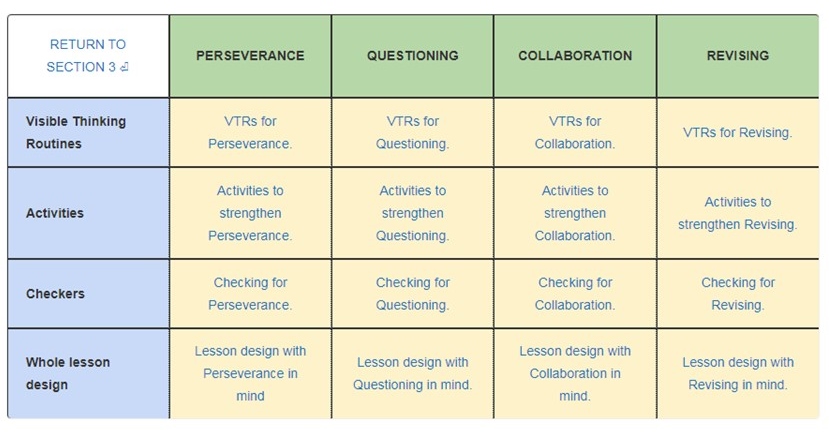
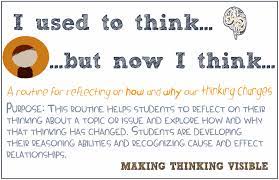
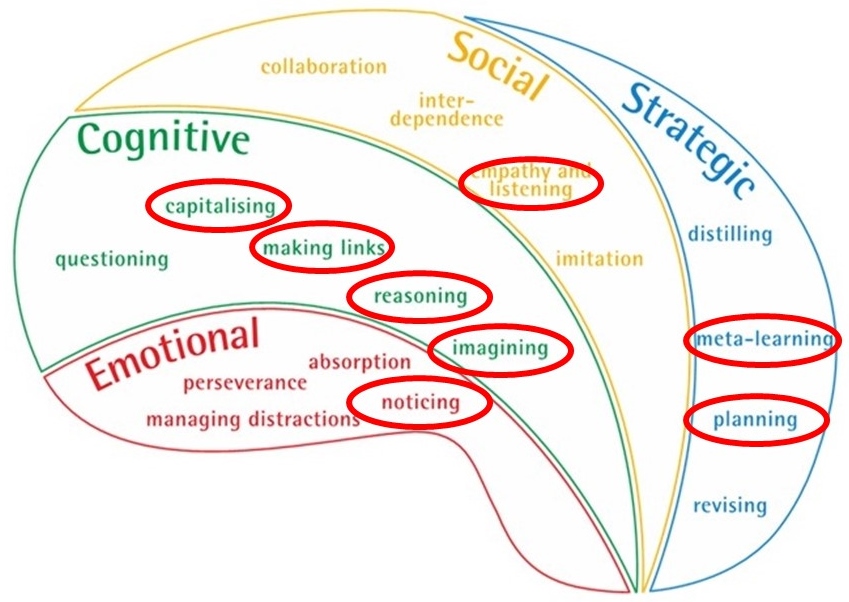
Comments are closed.